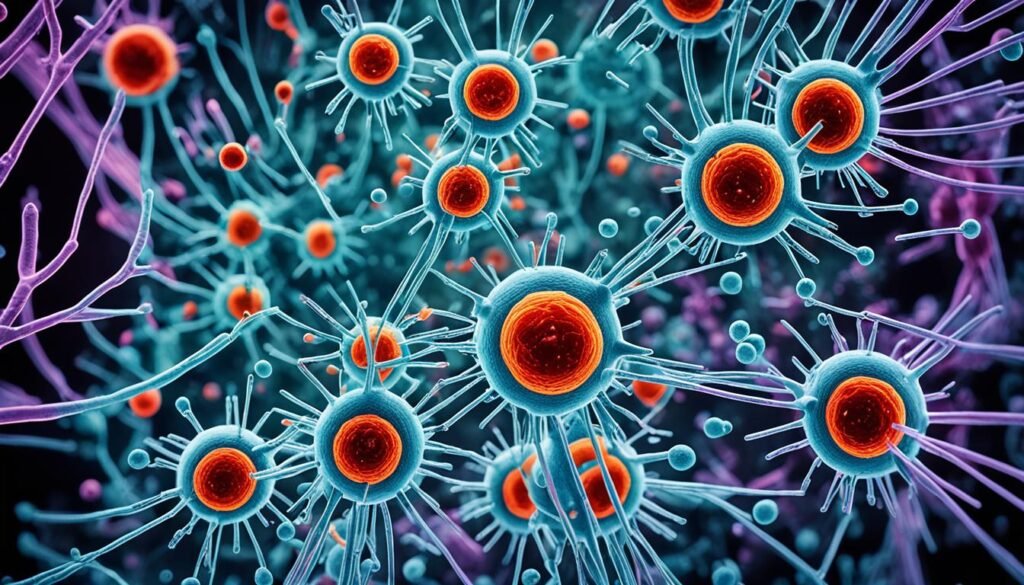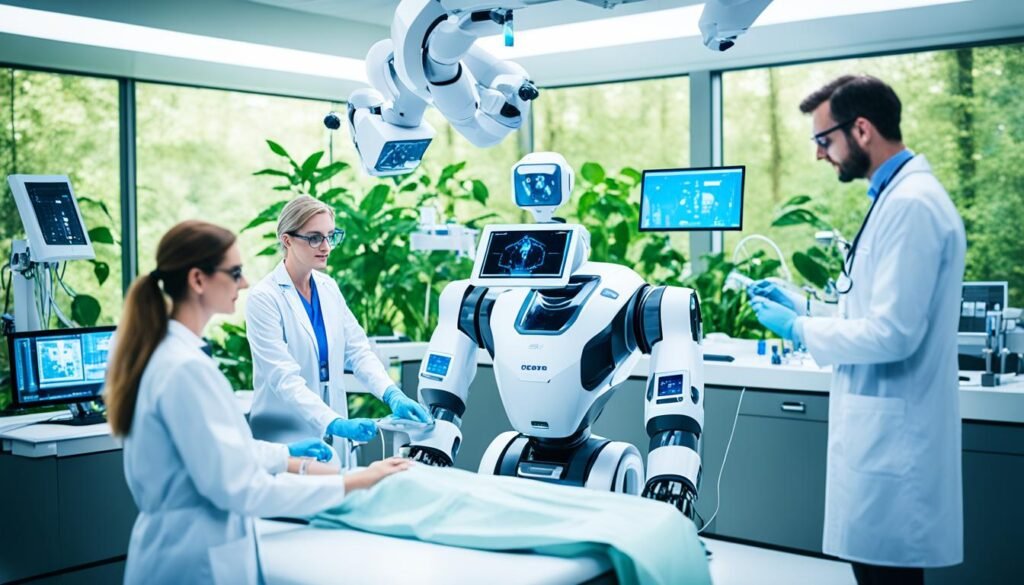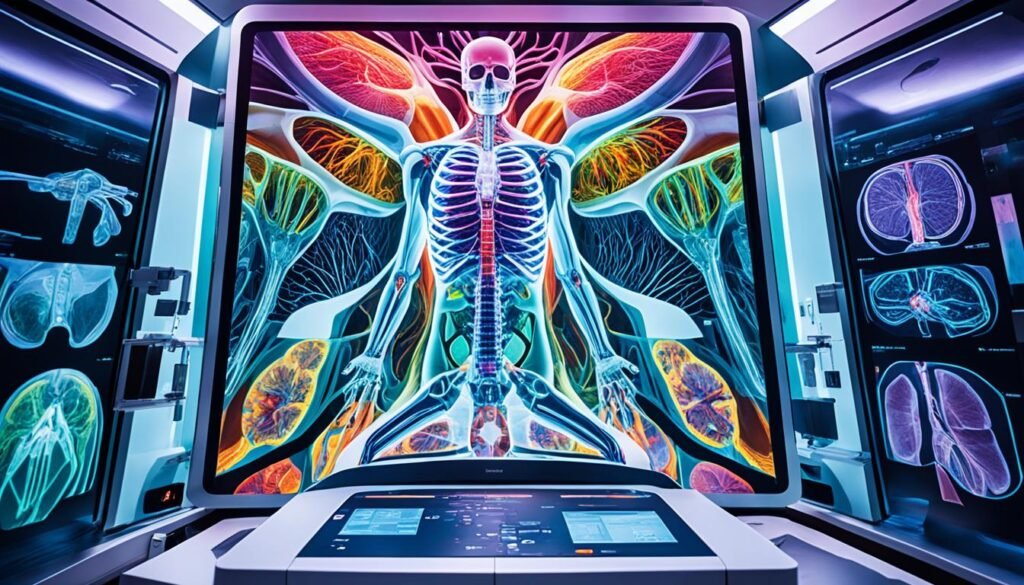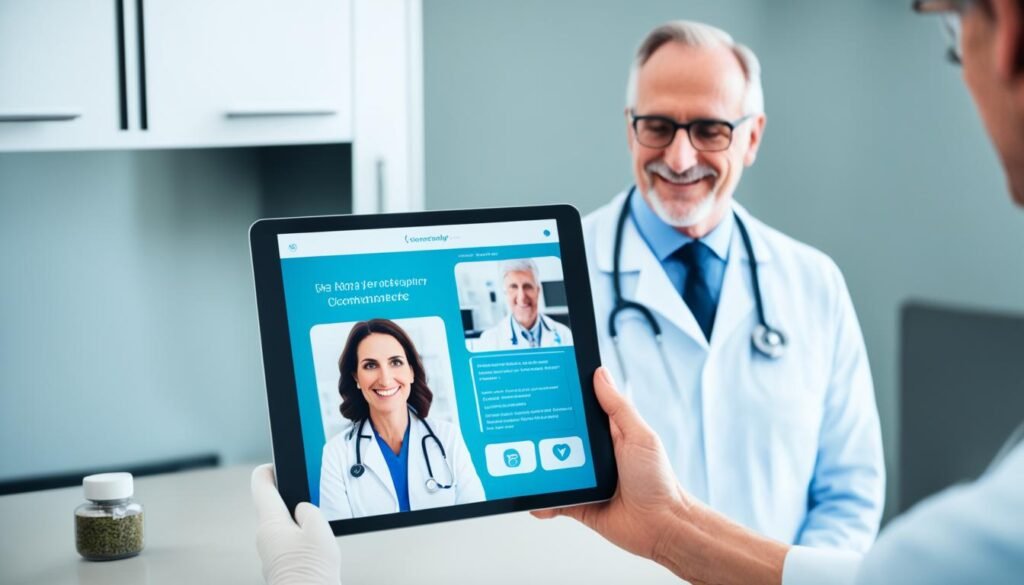Medical science is at the forefront of groundbreaking advances that are pushing the boundaries of healthcare, disease treatment, and biomedical innovation. Through constant research and technological advancements, the field of medical science continues to evolve, leading to new discoveries and improvements in healthcare.
From the development of smart drug delivery systems for precise cancer therapy to the use of nanotechnology in cancer treatment, medical science remains at the forefront of innovation in healthcare. These advancements have the potential to revolutionize disease treatment, improve patient outcomes, and enhance health technology.
Key Takeaways:
- Medical science is driving groundbreaking advances in healthcare.
- Constant research and technological advancements lead to new discoveries.
- Smart drug delivery systems and nanotechnology are transforming disease treatment.
- Medical science has the potential to revolutionize healthcare outcomes.
- Advancements in health technology are improving patient care.
Breakthroughs in Regenerative Medicine and Stem Cell Research
Regenerative medicine and stem cell research have revolutionized the field of medicine. Researchers are exploring the potential of stem cells to regenerate damaged tissues and organs, leading to potential breakthroughs in treating conditions such as spinal cord injuries, heart disease, and skin disorders.
The development of 3D bioprinting technology has also opened new possibilities in tissue engineering and organ transplantation, allowing for the creation of functional organs and tissues in the lab.
Advancements in Stem Cell Research
Stem cell research holds immense promise in the field of regenerative medicine. Stem cells are undifferentiated cells that have the ability to develop into various specialized cell types. Through careful manipulation, scientists can harness the regenerative potential of stem cells to repair and replace damaged or diseased tissues.
“Stem cells offer tremendous potential in the field of regenerative medicine, as they have the unique ability to renew and differentiate into different cell types,” said Dr. Emily Johnson, a renowned stem cell researcher at the Regenerative Medicine Institute.
The use of stem cells has shown promising results in the treatment of various medical conditions. For instance, in the case of spinal cord injuries, stem cell therapy aims to replace damaged nerve cells and restore neurological function. Early studies have demonstrated significant improvements in motor function and sensory perception after stem cell transplantation.
The Game-Changing Potential of 3D Bioprinting
3D bioprinting is a cutting-edge technology that has the potential to revolutionize tissue engineering and organ transplantation. It involves the precise layer-by-layer deposition of biomaterials, living cells, and growth factors to create functional living structures.
With 3D bioprinting, researchers can fabricate complex three-dimensional structures that mimic the architecture and function of natural tissues and organs. This breakthrough technology holds promise for providing patients with customized organs and tissues, eliminating the need for organ transplantation from donors.
“3D bioprinting has the potential to revolutionize organ transplantation by allowing us to create patient-specific organs that are biocompatible and fully functional,” said Dr. Michael Davis, a leading expert in tissue engineering and 3D bioprinting.
Recent Breakthroughs in Regenerative Medicine
Regenerative medicine continues to make significant advancements, pushing the boundaries of what is possible in medical treatment. Recent breakthroughs include:
- Successful regeneration of damaged cardiac tissue using stem cell therapy, improving heart function in patients with heart failure.
- Growing functional human liver tissue in the lab, offering hope for patients awaiting liver transplants.
- Development of skin grafts using 3D bioprinting, enabling the creation of personalized skin grafts that match the patient’s unique characteristics.
The Future of Regenerative Medicine
Regenerative medicine and stem cell research hold immense potential for the future of healthcare. Continued advancements in these fields will pave the way for novel treatments and therapies that can transform the lives of patients suffering from debilitating conditions.
As researchers delve deeper into the regenerative capabilities of stem cells and refine 3D bioprinting technology, the possibilities for tissue regeneration and organ transplantation become increasingly exciting.
Advancements in Cancer Research and Treatment

Cancer research has made remarkable progress in recent years, paving the way for innovative approaches in cancer treatment. This ongoing research has led to significant advancements in precision medicine, targeted therapies, immunotherapy, and gene editing, revolutionizing the way we combat cancer.
Precision medicine, also known as personalized medicine, has transformed cancer care by tailoring treatment plans to an individual’s unique genetic makeup. By analyzing a patient’s genetic profile, doctors can determine the most effective drugs and therapies, minimizing side effects and improving outcomes. This targeted approach has shown great promise in improving patient responses and overall survival rates.
Targeted therapies have also played a vital role in advancing cancer treatment. These therapies specifically target cancer cells while sparing healthy cells, reducing the harm caused by conventional treatments like chemotherapy and radiation. By targeting specific molecules or cellular pathways, targeted therapies disrupt cancer’s growth and spread, leading to better treatment outcomes.
“Precision medicine and targeted therapies have revolutionized cancer care by tailoring treatments to an individual’s specific genetic makeup.”
Immunotherapy, another groundbreaking advancement, harnesses the body’s immune system to fight cancer. It stimulates the immune system to recognize and destroy cancer cells, helping to eradicate tumors and prevent their recurrence. Immunotherapy has shown impressive results in treating various types of cancers, including melanoma, lung cancer, and bladder cancer.
Furthermore, the development of gene editing technologies, such as CRISPR/Cas9, has opened up new avenues for personalized cancer therapies. Gene editing allows scientists to modify a patient’s genes to correct genetic defects or enhance the body’s ability to combat cancer. This promising field of research holds tremendous potential for developing innovative treatments and improving patient outcomes.
Overall, cancer research continues to drive significant advancements in treatment strategies, bringing hope to millions of patients worldwide. Through precision medicine, targeted therapies, immunotherapy, and gene editing, healthcare professionals are becoming better equipped to fight cancer and improve patient outcomes.
| Treatment Approach | Advantages |
|---|---|
| Precision Medicine |
|
| Targeted Therapies |
|
| Immunotherapy |
|
| Gene Editing |
|
Nanotechnology in Medicine

Nanotechnology has revolutionized the field of medicine, introducing new possibilities for targeted drug delivery, diagnostic imaging, and precision medicine. The use of nanoparticles as drug delivery systems has transformed cancer therapy, allowing for the efficient and precise delivery of therapeutics to tumor cells while minimizing damage to healthy tissues.
By encapsulating chemotherapy drugs within nanoparticles, researchers have been able to enhance drug stability, prolong drug circulation in the bloodstream, and improve drug accumulation within tumors, leading to enhanced therapeutic efficacy and reduced side effects.
Furthermore, nanoparticles have proven invaluable in the field of diagnostic imaging. By attaching imaging agents to nanoparticles, researchers can improve the sensitivity and specificity of imaging techniques, enabling the early detection and accurate imaging of diseases such as cancer. This has significant implications for early intervention and effective monitoring of disease progression.
The field of nanotechnology has also contributed to the development of precision medicine by enabling targeted therapies. By engineering nanoparticles to deliver specific therapeutic agents, researchers can design treatment strategies tailored to an individual’s genetic and molecular profile. This personalized approach increases treatment effectiveness while minimizing adverse reactions.
Advantages of Nanotechnology in Medicine:
- Targeted drug delivery to specific cells or tissues
- Enhanced therapeutic efficacy with reduced side effects
- Improved sensitivity and specificity of diagnostic imaging
- Early detection and accurate imaging of diseases
- Tailored treatment strategies based on individual genetic and molecular profiles
The potential of nanotechnology in medicine is vast, and ongoing research and development continue to drive innovation in the field. By harnessing the power of nanotechnology, we can expect to see further advancements in drug delivery systems, diagnostic imaging techniques, and precision medicine approaches, ultimately leading to improved patient outcomes and more effective disease management.
Innovations in Artificial Organs

Artificial organs have revolutionized the field of medicine, offering new hope to patients suffering from organ failure. With advancements in technology, scientists and researchers have made significant progress in the development of artificial organs that can be used for organ transplantation.
Wearable Artificial Kidneys
One remarkable innovation in the field of artificial organs is the development of wearable artificial kidneys. These devices are designed to mimic the functions of a healthy kidney, filtering waste products from the blood and producing urine. Wearable artificial kidneys offer several advantages over traditional dialysis machines, including increased mobility and improved quality of life for patients with end-stage renal disease.
Here is a comparison between wearable artificial kidneys and traditional dialysis machines:
| Wearable Artificial Kidneys | Traditional Dialysis Machines |
|---|---|
| Portable and wearable | Stationary |
| Continuous filtration | Intermittent treatments |
| Improved mobility for patients | Restricted mobility |
3D Bioprinting of Artificial Organs
Another exciting advancement in the field of artificial organs is 3D bioprinting. This technology allows for the creation of functional organs and tissues using a patient’s own cells. By layering bioinks containing living cells, scientists can create complex structures that closely resemble natural organs. This opens up new possibilities for organ transplantation, as it reduces the need for organ donors and the risk of rejection.
One remarkable example of 3D bioprinting is the creation of artificial hearts. Scientists have successfully printed intricate heart structures using a patient’s own cells, paving the way for personalized and transplantable artificial hearts.
Artificial Hearts
Artificial hearts are one of the most significant developments in the field of artificial organs. These devices are designed to support or replace the functions of a failing heart. They can be used as a bridge to transplantation or as a long-term solution for patients who are not suitable candidates for heart transplantation.
Innovations in artificial organs, such as wearable artificial kidneys, 3D bioprinting, and artificial hearts, have the potential to save lives and improve the quality of life for patients in need of organ transplantation.
Artificial organs have the power to transform healthcare by offering new treatment options and improving patient outcomes. Continued research and advancements in the field of artificial organs hold promise for a future where organ transplantation becomes more accessible and successful.
Role of Artificial Intelligence in Medical Science

Artificial intelligence (AI) and machine learning have become integral to the field of medical science, revolutionizing healthcare delivery and patient outcomes. By analyzing vast amounts of data and utilizing advanced algorithms, AI systems can assist in medical imaging interpretation, aid in the development of personalized treatment plans, and improve overall patient care.
Medical imaging plays a crucial role in diagnosing and monitoring diseases. With the help of AI, medical professionals can achieve more accurate and efficient image analysis, allowing for quicker and more precise diagnosis. AI algorithms can analyze medical images such as MRIs, CT scans, and X-rays, identifying patterns and anomalies that may not be immediately apparent to human observers.
Additionally, AI can contribute to the advancement of precision medicine by analyzing large datasets and identifying patterns that can lead to personalized treatment plans. With the integration of machine learning algorithms, medical professionals can predict patient outcomes, optimize drug therapies, and enhance treatment recommendations based on individual patient characteristics.
The role of AI in medical science extends beyond imaging and treatment plans. Data analysis powered by AI can uncover hidden patterns and correlations, facilitating medical research and driving scientific discoveries. By identifying trends and associations in large-scale medical datasets, AI can assist in identifying risk factors, predicting disease outcomes, and guiding the development of targeted interventions.
Furthermore, AI-powered decision support systems can aid healthcare professionals in making informed clinical decisions. These systems can analyze patient data and medical records, providing evidence-based recommendations for diagnosis, treatment options, and follow-up care. By leveraging AI, medical practitioners can reduce diagnostic errors, improve treatment efficacy, and enhance patient safety.
Advantages of AI in Medical Science:
- Accurate and efficient medical imaging interpretation.
- Personalized treatment plans based on individual patient characteristics.
- Identification of patterns and correlations in large-scale medical datasets.
- Improved clinical decision-making through evidence-based recommendations.
As the field of medical science continues to evolve, the integration of AI and machine learning holds great potential for advancements in healthcare technology and patient care. However, it is vital to ensure the responsible and ethical use of AI, prioritizing patient privacy, data security, and transparency to shape a future where AI is seamlessly integrated into the practice of medicine, benefiting both healthcare professionals and patients alike.
Advancements in Imaging Technologies

Imaging technologies have undergone significant advancements in recent years, revolutionizing medical science and transforming the way we understand and diagnose diseases. High-resolution imaging techniques such as MRI scanning and cellular imaging have played a crucial role in providing detailed insights into the structure and function of the human body.
Neuroimaging techniques have enabled researchers and medical professionals to visualize the brain and its complex neural networks, leading to breakthroughs in understanding brain disorders and neurological conditions.
In addition, the incorporation of nanotechnology has contributed to the development of advanced imaging probes, enabling targeted imaging of specific cells or tissues. This targeted approach enhances diagnostic accuracy and allows for a deeper understanding of disease processes at the cellular level.
Furthermore, the use of high-resolution imaging methods provides exceptional detail, enabling healthcare professionals to detect even subtle abnormalities and effectively tailor treatment plans. This precision has significantly improved the accuracy of diagnoses and enhanced patient outcomes.
Advancements in MRI Scanning
MRI scanning, a non-invasive imaging technique that uses strong magnetic fields and radio waves, has witnessed significant advancements. The technology has evolved to provide higher resolution images, faster scanning times, and improved patient comfort.
- High-field MRI scanners: These scanners utilize stronger magnetic fields, resulting in better image quality and increased sensitivity.
- Faster imaging techniques: Developments such as parallel imaging and compressed sensing have reduced the time required for MRI scanning, allowing for quicker and more efficient examinations.
- Functional MRI (fMRI): This technique allows for the visualization of brain activity by measuring changes in blood flow. It has been instrumental in mapping brain function and understanding neural pathways.
- Diffusion MRI: This technique measures the movement of water molecules in tissues, providing valuable information about the integrity of tissue structures and the presence of abnormalities.
These advancements in MRI scanning have revolutionized diagnostic capabilities, enabling healthcare professionals to make more accurate diagnoses and facilitate more effective treatment strategies.
Cellular Imaging Techniques
Cellular imaging techniques have paved the way for a better understanding of cellular structures and functions, delivering insights into disease processes at the microscopic level. These techniques utilize a range of technologies, including fluorescence microscopy, confocal microscopy, and super-resolution microscopy.
Fluorescence microscopy involves labeling cells with fluorescent molecules, allowing for the visualization and tracking of specific cellular components or processes.
Confocal microscopy uses a focused beam of light to capture images from different layers of a biological sample. This technique provides detailed three-dimensional information and aids in visualizing complex cellular structures.
The emergence of super-resolution microscopy techniques has pushed the boundaries of imaging resolution, allowing researchers to visualize cellular structures with unprecedented detail. Examples of super-resolution techniques include stimulated emission depletion (STED) microscopy and structured illumination microscopy (SIM).
Confocal Microscopy
- Three-dimensional information
- Visualization of complex cellular structures
| Imaging Technique | Advantages |
|---|---|
| Fluorescence Microscopy |
|
| Super-Resolution Microscopy |
|
These advancements in cellular imaging techniques have propelled our understanding of cellular biology and disease pathology, helping to advance medical research and develop targeted therapies.
“Advancements in imaging technologies have not only enhanced our ability to diagnose diseases but have also allowed us to delve deeper into the intricate workings of the human body. This deeper understanding opens new doors for innovative treatments and personalized approaches to healthcare.” – Dr. Sarah Williams, Research Scientist
The Impact of Advancements in Imaging Technologies
The advancements in neuroimaging, nanotechnology, high-resolution imaging, MRI scanning, and cellular imaging have had a profound impact on medical science and patient care. These sophisticated imaging technologies have improved diagnostic accuracy, allowing for earlier detection and intervention for various conditions.
The detailed insights provided by these imaging techniques empower healthcare professionals to make informed treatment decisions, resulting in better patient outcomes. By visualizing the structure and function of the human body at different levels, medical researchers can also gain a deeper understanding of disease mechanisms and develop innovative therapeutic approaches.
Overall, advancements in imaging technologies continue to revolutionize medical science, driving innovations that improve diagnostic capabilities, facilitate targeted treatments, and transform patient care.
The Future of Precision Medicine
Precision medicine is poised to revolutionize healthcare by customizing treatment plans according to individual patients’ genetic makeup, lifestyle, and environmental factors. This innovative approach aims to improve patient outcomes by providing personalized therapies that target specific characteristics of each individual. Thanks to advancements in genomics and data analysis, precision medicine offers new opportunities for accurate diagnosis and effective treatment in various medical disciplines.
In the field of genomics, researchers have made significant progress in understanding the relationship between genetic markers and disease susceptibility. By analyzing an individual’s genetic information, healthcare professionals can identify biomarkers that indicate the presence or progression of certain diseases. This enables early detection and targeted intervention, leading to improved prognosis and tailored treatment plans.
“Precision medicine holds the promise of transforming healthcare by offering treatments that are tailored to each patient’s unique characteristics, improving both efficacy and safety.”
Furthermore, data analysis plays a crucial role in precision medicine. With the integration of big data and advanced analytics, healthcare providers can gain valuable insights into the complex relationships between genes, diseases, and treatment outcomes. By leveraging data-driven approaches, medical professionals can make informed decisions about the most suitable treatment options for their patients.
Personalized Therapies
One of the key benefits of precision medicine is the development of personalized therapies. Rather than relying on a one-size-fits-all approach, personalized therapies take into account an individual’s unique genetic profile, ensuring targeted and effective treatment. This approach has shown remarkable success in the field of oncology, where targeted therapies have improved survival rates and reduced side effects for cancer patients.
For example, in patients with certain types of lung cancer, the presence of specific genetic mutations can determine the most effective treatment options. By analyzing the tumor’s genomic profile, healthcare providers can prescribe targeted therapies that inhibit the growth of cancer cells while sparing healthy tissues.
The Power of Biomarkers
Biomarkers play a crucial role in precision medicine. These measurable indicators, which can be genetic, molecular, or environmental in nature, provide valuable information about an individual’s health status and response to treatment. By identifying specific biomarkers associated with particular diseases, medical professionals can develop more accurate diagnostic tests and tailor treatment plans accordingly.
For example, in the field of cardiovascular medicine, biomarkers such as cholesterol levels, blood pressure, and genetic predispositions can help predict an individual’s risk of developing heart disease. This enables healthcare providers to implement preventive measures and prescribe targeted interventions to mitigate the risk.
Data Analysis and Advanced Technologies
Data analysis plays a fundamental role in precision medicine, as it allows for the identification of patterns and trends that can inform treatment decisions. By leveraging artificial intelligence (AI) and machine learning algorithms, healthcare providers can analyze vast amounts of data, including genomic information, medical records, and clinical trial results, to generate actionable insights.
These advanced technologies enable healthcare professionals to not only interpret complex data but also predict disease progression, optimize treatment plans, and identify potential side effects. With the integration of AI and machine learning, precision medicine has the potential to transform the way healthcare is delivered, improving patient outcomes and reducing healthcare costs.
Telemedicine and Digital Health Solutions

The advancement of technology has revolutionized the healthcare industry, leading to the emergence of telemedicine and digital health solutions. Telemedicine allows patients to access medical care remotely, breaking geographical barriers and providing enhanced access to healthcare services. With the help of digital platforms, healthcare professionals can connect with patients through video consultations, telephone calls, or online messaging systems.
Remote patient monitoring is a crucial aspect of digital health solutions. It enables continuous monitoring of patients’ health status, allowing for early detection of diseases and improved management of chronic conditions. Wearable devices, such as fitness trackers and smartwatches, have become commonplace, providing real-time data on vital signs, daily activities, and sleep patterns.
Healthcare technology has also transformed the way patients access medical information and manage their health. Mobile applications and online portals allow individuals to schedule appointments, access their medical records, and receive personalized health information. These digital tools empower patients to take an active role in their healthcare journey and make informed decisions.
The benefits of telemedicine and digital health solutions are far-reaching. They not only improve patient care but also streamline healthcare delivery and reduce healthcare costs. Patients can seek medical advice from the comfort of their own homes, eliminating the need for travel and reducing waiting times. Additionally, telemedicine and digital health solutions enable healthcare providers to reach underserved populations, improving healthcare accessibility for all.
One of the significant advantages of telemedicine is its ability to provide healthcare services to rural and remote areas where access to healthcare facilities may be limited. With telehealth, patients living in remote regions can receive medical consultations from specialists located in urban areas, ensuring they receive the same level of care as those in metropolitan regions.
Telemedicine vs. Telehealth: What’s the Difference?
While often used interchangeably, telemedicine and telehealth are two distinct terms that encompass different aspects of remote healthcare.
- Telemedicine refers specifically to the delivery of clinical services through telecommunications technology. It involves remote consultations between healthcare providers and patients, allowing for diagnosis, treatment, and prescription of medications without in-person visits.
- Telehealth is a broader term that encompasses all healthcare services provided remotely, including non-clinical services. Telehealth includes administrative tasks, patient education, remote monitoring, and more.
Both telemedicine and telehealth play crucial roles in expanding healthcare access, improving patient outcomes, and transforming the healthcare landscape.
Benefits of Telemedicine and Digital Health Solutions
“Telemedicine and digital health solutions have the potential to enhance patient care and improve healthcare outcomes.”
Telemedicine and digital health solutions offer numerous benefits to patients, healthcare providers, and the healthcare system as a whole:
| Benefits for Patients | Benefits for Healthcare Providers | Benefits for the Healthcare System |
|---|---|---|
| – Enhanced access to healthcare services – Convenience and flexibility – Reduced travel time and costs – Improved management of chronic conditions |
– Increased efficiency in healthcare delivery – Expanded patient reach – Streamlined workflows – Enhanced collaboration and communication |
– Reduced healthcare costs – Improved healthcare accessibility – Enhanced population health management – Prevention of unnecessary hospital visits |
By leveraging telemedicine and digital health solutions, healthcare providers can deliver high-quality care to a broader population, enhancing patient satisfaction and improving healthcare outcomes. These technologies support the transition from a reactive to a proactive approach to healthcare, enabling early intervention, timely treatment, and preventive measures.
The future of healthcare lies in the fusion of medical expertise and technology. Telemedicine and digital health solutions have the potential to revolutionize healthcare delivery, making quality healthcare accessible to everyone.
Medical science covers many subjects which try to explain how the human body works. Starting with basic biology it is generally divided into areas of specialisation, such as anatomy, physiology and pa
Meet the 2022 Class
Conclusion
Medical science plays a vital role in driving healthcare advancements through innovative biomedical research and scientific discoveries. As the field continues to evolve, new breakthroughs and technologies are reshaping our understanding and treatment of diseases. From regenerative medicine and nanotechnology to artificial intelligence and precision medicine, the future of healthcare holds immense promise.
By harnessing the power of medical science, we can expect continued advancements in health technology and improved patient outcomes. The development of regenerative medicine and stem cell research has opened doors to potential breakthroughs in treating conditions such as spinal cord injuries and heart disease. Nanotechnology, with its drug delivery systems and diagnostic imaging techniques, has the potential to revolutionize treatment approaches and drive precision medicine.
Artificial organs, including wearable artificial kidneys and 3D bioprinted organs, offer hope to patients with organ failure, while advancements in artificial intelligence and machine learning enable more accurate diagnoses and personalized treatment plans. Imaging technologies, such as neuroimaging and high-resolution imaging, provide detailed insights into the human body, while telemedicine and digital health solutions enhance access to healthcare services and enable continuous monitoring of patients.
In conclusion, medical science is at the forefront of healthcare advancements, paving the way for improved patient care and better health outcomes. With ongoing biomedical research and scientific discoveries, the future holds great promise for the continued evolution of health technology and the enhancement of healthcare delivery.
FAQs
Q: What are some of the key research areas in the field of medical science?
A: Some key research areas in medical science include molecular biology, pathology, biochemistry, microbiology, and substance use.
Q: What is the significance of breakthroughs in medical science?
A: Breakthroughs in medical science can lead to advancements in treating diseases, improving human health, and developing new medical technologies.
Q: How can students stay updated on the latest developments in medical science?
A: Students can use tools like the journal browser to access current research articles and stay informed about the latest advancements in medical science.
Q: What are some potential applications of advancements in medical science?
A: Advancements in medical science can have potential applications in fields such as infectious disease research, biotechnology, pharmaceuticals, and radiotherapy.
Q: What role does peer-review play in the field of medical science?
A: Peer-review is a crucial part of the scientific process in medical science, ensuring that research studies are evaluated and validated by experts before publication.
Q: How do breakthroughs in medical science contribute to the understanding and treatment of diseases?
A: Breakthroughs in medical science, such as advancements in molecular biology and biochemistry, provide insights into the mechanisms of diseases and help in developing new treatments.
Q: Can you explain the importance of molecular biology in the field of medical science?
A: Molecular biology is essential in medical science as it studies the molecular mechanisms underlying diseases, genetics, and drug interactions, leading to cutting-edge research and treatments.




